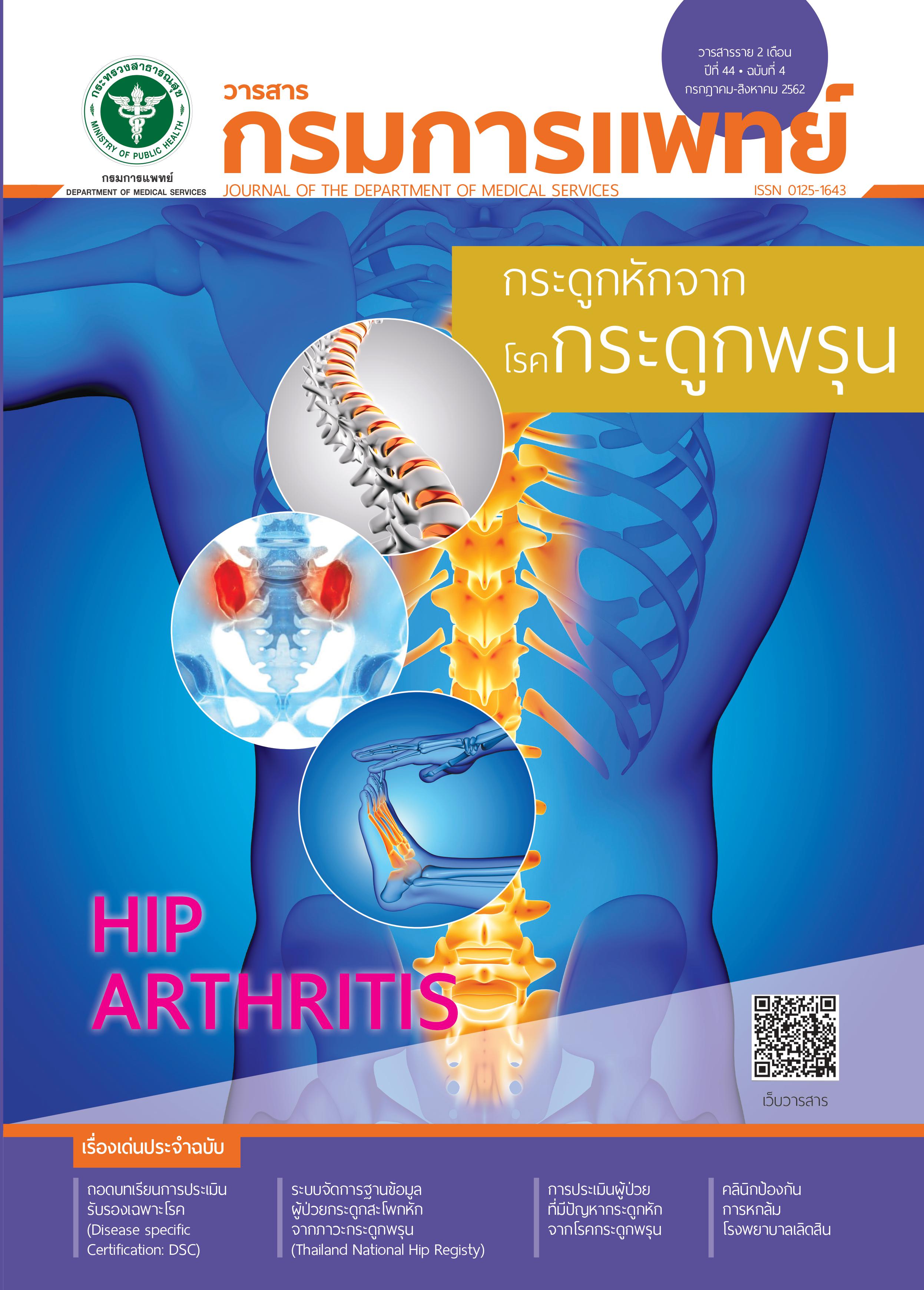คุณภาพชีวิตของผู้ป่วยเด็กโรคเหาก่อนและหลังรับการรักษา
คำสำคัญ:
โรคเหา, คุณภาพชีวิต, การวัดคุณภาพชีวิตของผู้ป่วยโรคผิวหนังในเด็กบทคัดย่อ
ภูมิหลัง: โรคเหาเป็นโรคติดต่อที่พบได้บ่อยในเด็ก ผู้ป่วยจะมีอาการคัน เกา เกิดความรู้สึกอับอาย ต้องเปลี่ยนแปลงการคำเนินชีวิตประจำวันเพื่อป้องกันการติดต่อสู่ผู้อื่น มีขั้นตอนและระยะเวลารักษายาวนาน ข้อมูลเรื่องผลกระทบต่อคุณภาพชีวิตของผู้ป่วยเด็กโรคเหามีอยู่น้อย วัตถุประสงค์: เพื่อศึกษาคุณภาพชีวิตของเด็กที่เป็นโรคเหา และเปรียบเทียบคุณภาพชีวิตก่อนและหลังรับการรักษา วิธีการ: เด็กนักเรียนชั้นประถมศึกษาปีที่ 1 ถึงมัธยมศึกษาปีที่ 3 ที่โรงเรียนแห่งหนึ่งในจังหวัดชลบุรีได้รับการตรวจค้นหาเหาและรักษาด้วยยา 1% permethrin lotion เด็กจำนวน 50 คน ตอบแบบสอบถามประเมินคุณภาพชีวิตโรคผิวหนังในเด็กก่อนและหลังรักษา แบบสอบถามประกอบด้วย 10 คำถาม 30 คะแนน คะแนนมากหมายถึงคุณภาพชีวิตไม่ดี ศึกษาและเปรียบเทียบผลคุณภาพชีวิตเด็กที่เป็นโรคเหาก่อนและหลังจากรักษา 2 สัปดาห์ ผล: เด็กที่เป็นเหามีช่วงคะแนนคุณภาพชีวิต 0-23 คะแนน เด็กจำนวนร้อยละ 8 ได้รับผลกระทบต่อคุณภาพชีวิตในระดับมากที่สุด คะแนนเฉลี่ยของเด็กนักเรียนทั้งหมดที่เป็นเหามีคุณภาพชีวิตอยู่ในระดับด้อยลงเล็กน้อย คะแนนเฉลี่ยคุณภาพชีวิตก่อนและหลังรักษา คือ 5.00 และ 3.16 คะแนน หลังรักษา มีค่าเฉลี่ยคะแนนคุณภาพชีวิตดีขึ้น 1.84 คะแนน (95% CI: 0.19, 3.49, p=0.029) คำถามที่มีจำนวนผู้ป่วยได้รับผลกระทบมากที่สุด คือ เรื่องอาการคันอยากเกา แสบ หรือเจ็บปวดที่ผิวหนัง คำถามที่มีคะแนนคุณภาพชีวิตดีขึ้นหลังรักษาได้แก่ 1) ความรู้สึกอับอายหรือรำคาญ กระวนกระวาย หงุดหงิด เศร้า 2) การดำเนินกิจกรรมในชีวิตประจำวันช่วงไปโรงเรียน ผลกระทบต่อการเรียน โดยกลุ่มนักเรียนที่พบว่ามีคุณภาพชีวิตดีขึ้นอย่างมีนัยสำคัญทางสถิติหลังรักษาเหา คือ กลุ่มที่ตรวจไม่พบตัวเหาหลังรักษา และกลุ่มช่วงอายุวัยรุ่น 12 – 15 ปี สรุป: โรคเหาส่งผลให้คุณภาพชีวิตด้อยลงเล็กน้อย การรักษาเหาทำให้คุณภาพชีวิตผู้ป่วยในภาพรวมดีขึ้น ช่วยให้ลดความรู้สึกอับอาย และส่งผลดีต่อการดำเนินกิจกรรมในชีวิตประจำวันช่วงไปโรงเรียน โดยเฉพาะในกลุ่มผู้ป่วยที่ตรวจไม่พบตัวเหาหลังรักษา และกลุ่มวัยรุ่น
เอกสารอ้างอิง
Cummings C, Finlay JC, MacDonald NE. Head lice infestations: A clinical update. J Paediatr Child Health 2018; 23: e18-24.
Devore CD, Schutze GE; AAP, Council on School Health, Committee on Infectious Dises. Head Lice. Pediatrics 2015; 135: e1355-65.
Gratz NG, World Health Organization. Human lice: Their prevalence, control and resistance to insecticides: A review 1985-1997. Geneva: World Health Organization; 1997.
Falagas ME, Matthaiou DK, Rafailidis PI, Panos G, Pappas G: World- wide prevalence of head lice. Emerg Infect Dis. 2008; 14: 1493–4.
Lesshafft H, Baier A, Guerra H, Terashima A, Feldmeier H. Prevalence and risk factors associated with pediculosis capitis in an impoverished urban community in Lima, Peru. J Glob Infect Dis 2013; 5: 138–43.
Moosazadeh M, Afshari M, Keianian H, Nezammahalleh A, Enayati AA. Prevalence of head lice infestation and its associated factors among primary school students in Iran: a systematic review and meta-analysis. Osong Public Health Res Perspect 2015; 6: 346-56.
Thavara U, Phan-Urai P, Malainual A, Chansang C. Pediculosis among schoolchildren in rural areas of Thailand. J Depart Med Sci 1988; 30: 191-199.
Thanyavanich N, Maneekan P, Yimsamram S, Maneeboonyang W, Puangsa-art S, Wuthisen P, et al. Epidemiology and risk factors of pediculosis capitis in 5 primary school near the Thai-Myanmar border in Ratchaburi province, Thailand. J Trop Med Parasitol 2009; 32: 65-74.
Rassami W, Soonwera M. Epidemiology of pediculosis capitis among schoolchildren in the eastern area of Bangkok, Thailand. Asian Pac J Trop Biomed 2012; 2: 901-4.
Ruankham W, Winyangkul P, Bunchu N. Prevalence and factors of head lice infestation among primary school students in Northern Thailand. Asian Pac J Trop Dis 2016; 6: 778-82.
Wallander JL, Varni JW. Effects of pediatric chronic physical disorders on child and family adjustment. J Child Psychol Psychiatry 1998; 39: 29-46.
Wisuthsarewong W, Nitiyarom R, Ngamcherdtrakul P. The validity and reliability of the Thai version of Children’s Dermatology Life Quality Index (CDLQI). J Med Assoc Thai 2015; 98: 968-73.
Waters A, Sandhu D, Beattie P. Severity stratification of Children’s Dermatology Life Quality Index (CDLQI) scores. Br J Dermatol 2010 ; 163: 121.
Heukelbach J, Kuenzer M, Counahan M, Feldmeier H, Speare R. Correct diagnosis of current head lice infestation made by affected individuals from a hyperendemic area. Int J Dermatol 2006 ; 45: 1437-8.
Pilger D, Khakban A, Heukelbach J, Feldmeier H. Selfdiagnosis of active head lice infestation by individuals from an impoverished community: high sensitivity and specificity. Rev Inst Med Trop Sao Paulo 2008; 50: 121-2.
Vander Stichele RH, Gyssels L, Bracke C. Wet combing for head lice: feasibility in mass screening, treatment preference and outcome. J R Soc Med 2002; 95: 348–52.
Brown MM, Chamlin SL, Smidt AC . Quality of life in pediatric dermatology. Dermatol Clin. 2013; 31: 211–21.
Fienemika AE, Okeafor CU. The identification and grading of the psychosocial impact of Tinea capitis in primary school children in a semi-urban area of Rivers State, Nigeria. Niger Postgrad Med J 2017; 24: 20.
Olsen JR, Gallacher J, Finlay AY, Piguet V, Francis NA. Quality of life impact of childhood skin conditions measured using the Children’s Dermatology Life Quality Index (CDLQI): a meta ‐ analysis. Br J Dermatol 2016; 174: 853-61.
Parison JC, Speare R, Canyon DV. Uncovering family experiences with head lice: the difficulties of eradication. Open Dermatol J 2008; 2:9-17.
Rhongbutsri P, Saichua P, Navaphongpaveen K, Taylor A. Prevalence of Pediculosis Capitis in Handicapped Girls at Handicapped School in Khon Kaen Province. Journal of Science and Technology 2013; 21: 34-40.
Parison JC, Speare R, Canyon DV: Head lice: the feelings people have. Int J Dermatol. 2013; 52: 169–71.
Stough D, Shellabarger S, Quiring J, Gabrielsen AA. Efficacy and safety of spinosad and permethrin cream rinses for pediculosis capitis (head lice). Pediatrics. 2009; 124: e389-95.
Heukelbach J, Pilger D, Oliveira FA, Khakban A, Ariza L, Feldmeier H: A highly efficacious pediculicide based on dimeticone: randomized observer blinded comparative trial. BMC Infect Dis 2008; 8: 115.
Tanyuksel M, Araz RE, Albay A, Aycicek H. Prevalence and treatment of Pediculus humanus capitis with 1% permethrin and 0.4% d-phenothrin in Turkey. Acta Medica (Hradec Kralove) 2003; 46: 73–5.
บัญชียาหลักแห่งชาติ. Paraticidal preparations [database on the Internet]. 2016 [Accessed 1 Mar 2018]. Available from: http://drug.fda.moph.go.th:81/nlem.in.th/medicine/ essential/list/185
Feldmeier H. Treatment of pediculosis capitis: a critical appraisal of the current literature. Am J Clin Dermatol 2014; 15: 401-12.
Wadowski L, Balasuriya L, Price HN, O’Haver J. Lice update: new solutions to an old problem. Clin Dermatol 2015; 33: 347-54.
Cynthia Holland-Holl and Gale R.Burstein. Adolescent development. In: Behrman RE, Kliegman RM, et al. Nelson Textbook of Pediatrics. 20thed. Philadelphia. W.B. Saunders: 2016. P. 926.
Silverberg JI, Silverberg NB. Quality of life impairment in children and adolescents with vitiligo. Pediatr dermatol 2014; 31:309-18.
Heukelbach J, Wilcke T, Winter B, Feldmeier H. Epidemiology and morbidity of scabies and pediculosis capitis in resource ‐ poor communities in Brazil. Br J Dermatol 2005; 153: 150-6.
ดาวน์โหลด
เผยแพร่แล้ว
รูปแบบการอ้างอิง
ฉบับ
ประเภทบทความ
สัญญาอนุญาต
บทความที่ได้รับการตีพิมพ์เป็นลิขสิทธิ์ของกรมการแพทย์ กระทรวงสาธารณสุข
ข้อความและข้อคิดเห็นต่างๆ เป็นของผู้เขียนบทความ ไม่ใช่ความเห็นของกองบรรณาธิการหรือของวารสารกรมการแพทย์



